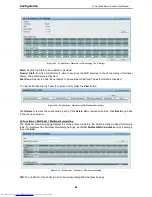
Configuration
D-Link Web Smart Switch User Manual
3
3
1
1
Figure 4.30 – Configuration > 802.1Q VLAN PVID
The 802.1Q Management VLAN setting allows user to transfer the authority of the switch from the default
VLAN to others created by users. This allows managing the whole network more flexible.
VLAN > 802.1Q Management VLAN
By default, the Management VLAN is disabled. You can select any existing VLAN as the management VLAN
when this function is enabled. There can only be one management VLAN at a time.
Figure 4.31 – Configuration > 802.1Q Management VLAN
Voice VLAN is a feature that allows you to automatically place the voice traffic from IP phone to an assigned
VLAN to enhance the VoIP service. With a higher priority and individual VLAN, the quality and the security of
VoIP traffic are guaranteed.
VLAN > Voice VLAN > Voice VLAN Global Settings
Figure 4.32 – VLAN > Voice VLAN > Voice VLAN Global Settings
Voice VLAN:
Select to enable or disable Voice VLAN. The default is
Disabled.
After you enabled Voice
VLAN, you can configure the Voice VLAN Global Settings.
VLAN ID:
The ID of VLAN that you want to assign voice traffic to. You must first create a VLAN from the
802.1Q VLAN window before you can assign a dedicated Voice VLAN. The member port configured in
802.1Q VLAN will be the static member port of voice VLAN. To dynamically add ports into the voice VLAN,
enable the
Auto Detection
function in the Voice VLAN Port Settings window.
Priority:
The 802.1p priority levels of the traffic in the Voice VLAN.
Aging Time (1-120):
Enter a period of time (in hours) to remove a port from the voice VLAN if the port is an
automatic VLAN member. When the last voice device stops sending traffic and the MAC address of this
voice device is aged out, the voice VLAN aging timer will start. The port will be removed from the voice VLAN
after the expiration of the voice VLAN aging timer. Selectable range is from 1 to 120 hours, and default is 1.
Click
Apply
to implement the changes made.
















































